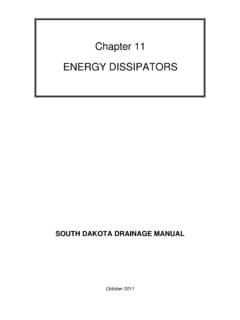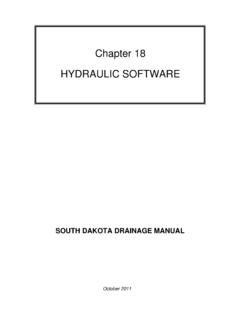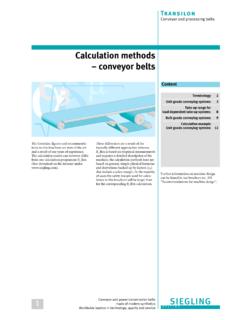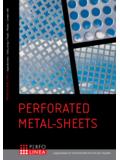Transcription of Chapter 8 - Concrete
1 Chapter 8 - Concrete Chapter 8 - Concrete Chapter 8 - Concrete Concrete is formed from a hardened mixture of cement, water, sand, rock, air and certain admixtures through the chemical reaction called Hydration. Chapter 8 - Concrete Nearly every structure constructed in SD will utilize Concrete in one form or another. The Chapter will cover Concrete from the point it is delivered to the construction site in its plastic state to its use in its final position. Inspection at Plant: This is covered in the Concrete Plants Manual Haul ticket Project Material Date Truck Number Water: Maximum Water: Actual Batch Size Time Start Mix Inspector: Plant Revolution: Initial Inspection at Delivery Your inspection of the Concrete begins when the Concrete reaches the structure site.
2 Your inspection focuses on items that affect the strength and durability of the Concrete . You will be tasked with performing the fresh Concrete testing and also to closely monitor the operations of the pour. Inspection at Delivery Time Limits Inspection items Amount of Mixing which ultimately Slump affect strength and durability of Concrete Air Content Temperature Concrete Cylinders Unit Weight Time Limits If Concrete placement takes too long, it will start to set up . The following limits have been specified: Concrete mixed in hauling unit (Redi-mix truck). 50 80o F. Discharge within 90 min. & screed within 105 min. 80 90o F. Discharge within 45 min. & screed within 60 min. Concrete not mixed in hauling unit (uncommon for structures). 50 80o F - Discharge within 45 min.
3 & screed within 60 min. 80 90o F - Discharge within 30 min. & screed within 45 min. Amount of Mixing Transit mixed Concrete - 70 revolutions (minimum). - 100 revolutions (maximum). Undermixed Segregation Coarse aggregate not fully coated Strength will be low Overmixed Grinding action produces fines - reduces slump Percent of air is reduced Temperature of Concrete is raised Strength will decrease Sampling Concrete Samples of bridge deck Concrete should be taken after placement on the bridge deck. Sample tested within 15 minutes from time taken Protect sample from sunlight and wind until used Do not use Concrete that has been previously used in the air test for any other test Leave sample taken from a mobile mixer in a covered container for 5.
4 Minutes before testing for slump and air Slump Specifications: Structural Concrete = 1 to 4 1/2 inches (Check first load and every 2 hours). Bridge Deck = 1 to 3 1/2 inches (Check first load and every hour after). Rule of thumb: For 1 Cu. Yd. of Concrete +1 gallon of water = +1 inch slump Air Content Specifications: All Concrete except bridge decks = - Bridge deck Concrete = - Adding water will increase slump and air content. Adding admixture to increase air content and will increase slump. Temperature Specifications: Structural Concrete = 50 90o F. Bridge Deck = 50 80o F. (max. temp. 85o F if cooling procedures are followed prior to pour). Concrete Cylinders Requirements: One set of four cylinders per day for each 150 cu yds of Concrete Covered with wet burlap and poly Protected at a temperature between 60 80o F.
5 Not moved after set occurs and no vibrations Within 24 8 hours, strip from mold and store in saturated lime water holding tank One cylinder broke in Central Lab at 28 days - other one for backup. Other two for early breaks. Concrete Placement Equipment Chutes Concrete Buckets Concrete Buggies Hoppers and Drop Tubes Tremie Pipes Concrete Pumps Conveyor Belts General Concrete Placement General Concrete Placement Time Requirements Placement Pattern Consolidation Water Infiltration Cold Weather Requirements Hot Weather Requirements (bridge deck). Time Requirements Place Concrete at a rate such that a layer does not set up . before next layer is placed Concrete delivery intervals should not exceed 30 minutes Placement Patterns Do not allow Concrete to be dumped in piles.
6 Concrete will segregate if the Contractor tries to move it from piles. Rock is heavy enough to stay put and only the mortar will tend to move. Floors, decks and other large areas - Start at one end and move towards the other, spreading evenly over the entire width. Walls - Layers should not be more than 6 - 12 inches deep and uniformly placed. Do not allow Concrete layers to be sloped as segregation can occur. Consolidation Eliminating voids and settling of Concrete is achieved by use of vibrators thus ensuring uniform density of mix Spud vibrators should be used in a vertical manner every 12 - 18 inches apart and in a grid pattern Vibrators should penetrate into previous lift Do not use them to move the Concrete Water Infiltration Seeping water can affect the quality and durability of the Concrete thus requiring care in eliminating it from the excavation before Concrete placement.
7 3 Methods to deal with seeping water: 1. Pump water out using a sump - low spot in excavation for collection point of water 2. Place a foundation seal 3. Place the Concrete under water Cold Weather Requirements Placement of Concrete bridge decks is not permitted from November 1 - April 1. Ground must not be frozen or frost on reinforcing steel or forms Use high-low thermometers especially when housing and heating Cold Weather Requirements Protection Period Concrete Temperatures: First 72 hours (3 days), 50 100o F. Next 48 hours (2 days), 40 100o F. Extra day of protection above 40 degrees F for each day temperature falls below the specified temp during these 5 days If housed and heated then removed after 5 days, temperature of Concrete can not drop more than 40.
8 Degrees in each 24 hour period If an extra bag of cement is added to mix or if high early cement is allowed, first 72 hours, 60 100o F. Cold Weather Requirements Housing and Heating Plan for use of high-low thermometers - place between insulation and Concrete at locations most likely to freeze Use enclosures and insulating blankets - secure from windy conditions Don't allow it to get too hot - have someone monitor enclosure Steam heat is the best due to moisture. Dry heat will pull the moisture out of the Concrete . Cold Weather Concrete Temperature Record - DOT 227. Spec also allows the Contractor to flood the Concrete a min depth of 1' for 10 days. Concrete Temps - Spans 10 & 11. 120. Deck Interior 100 Surface 80. Temp (F). 60. 40. 20. 0.
9 0 12 24 36 48 60 72 84 96 108 120 132. Hours Hot Weather Requirements (Bridge Deck Concrete ). Bridge Deck Concrete = 50 80o F. Bridge Deck Concrete = 50 85o F if: Rock pile is prewet a couple of days before pour Minimum rate of pour of 40 Cu. Yds. per hour or minimum plans rate is maintained Wet burlap and poly is placed as soon as Concrete is finished If ambient temperature > 80o F - continuous fogging shall be used Joints Joints Construction Joints or Expansion Joints Construction Joints - used when there is no way to place all the Concrete at one time. Joints Construction Joints or Expansion Joints Expansion Joints - provides a connection for different units of the structure but does not create a bond between them. Construction Joints Roughened Joint Roughened Concrete left high and trimmed prior to setup - Usually a wood float is used to finish and consolidate the surface Allows for grout removal Roughened joint is usually horizontal and has resteel passing through the joint Protect joint from curing compound Construction Joints Formed Joint - Form is placed and Concrete is consolidated up to the form.
10 (header). Keyways - Are indentations in Concrete that provide for load transfer. They can be used in formed or roughened joints Usually made of beveled wood - oiled Should be as continuous as possible Construction Joints Emergency Construction Joints Used when Contractor is unable to supply Concrete because of time limits, equipment breakdowns, or when weather conditions warrant one The location is not as critical for walls, floors, or columns although Concrete should be fairly level There are some key locations for these joints on various bridge decks Contact Office of Bridge Design if one is used Expansion Joints Accommodates movement of Concrete because of thermal temperature changes. (Provides room for the Concrete to expand). Expansion Joints Strip Seal Expansion Joint Usually over abutments or in approach slabs Installation is critical for long life - follow shop plans and manufacturer's installation instructions Note.












